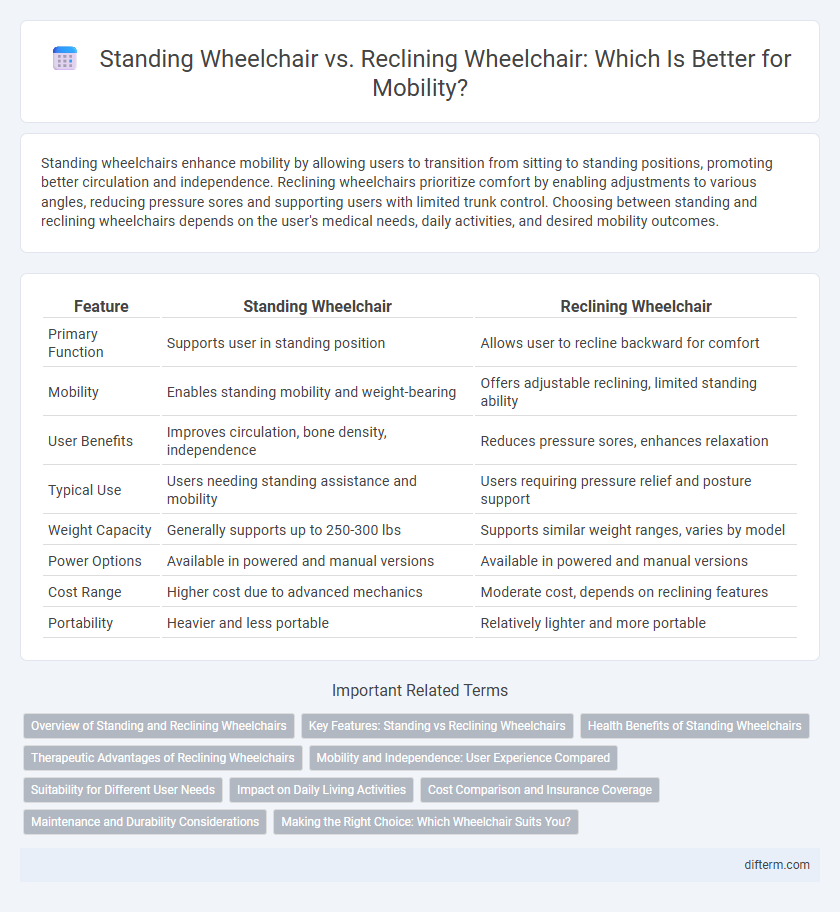Standing wheelchairs enhance mobility by allowing users to transition from sitting to standing positions, promoting better circulation and independence. Reclining wheelchairs prioritize comfort by enabling adjustments to various angles, reducing pressure sores and supporting users with limited trunk control. Choosing between standing and reclining wheelchairs depends on the user's medical needs, daily activities, and desired mobility outcomes.
Table of Comparison
| Feature | Standing Wheelchair | Reclining Wheelchair |
|---|---|---|
| Primary Function | Supports user in standing position | Allows user to recline backward for comfort |
| Mobility | Enables standing mobility and weight-bearing | Offers adjustable reclining, limited standing ability |
| User Benefits | Improves circulation, bone density, independence | Reduces pressure sores, enhances relaxation |
| Typical Use | Users needing standing assistance and mobility | Users requiring pressure relief and posture support |
| Weight Capacity | Generally supports up to 250-300 lbs | Supports similar weight ranges, varies by model |
| Power Options | Available in powered and manual versions | Available in powered and manual versions |
| Cost Range | Higher cost due to advanced mechanics | Moderate cost, depends on reclining features |
| Portability | Heavier and less portable | Relatively lighter and more portable |
Overview of Standing and Reclining Wheelchairs
Standing wheelchairs provide users with the ability to move between sitting and standing positions, promoting improved circulation, pressure relief, and enhanced social interaction. Reclining wheelchairs offer adjustable backrest angles to support various postures, aiding users with limited trunk control or those requiring pressure redistribution. Both designs emphasize user comfort and mobility but cater to different medical and lifestyle needs based on postural support and activity levels.
Key Features: Standing vs Reclining Wheelchairs
Standing wheelchairs offer powered mechanisms that enable users to transition from a seated to a fully upright position, promoting improved circulation, pressure relief, and social interaction, while their ergonomic design supports weight-bearing for bone health. Reclining wheelchairs provide adjustable backrests that tilt backward to redistribute pressure and enhance comfort, particularly beneficial for users with limited trunk control or those requiring frequent posture changes to prevent pressure ulcers. Both wheelchairs prioritize customized support and mobility, but standing models emphasize vertical mobility and health benefits tied to standing, whereas reclining models focus on posture variation and pressure management.
Health Benefits of Standing Wheelchairs
Standing wheelchairs significantly improve circulation and reduce the risk of pressure sores by allowing users to shift weight and change posture regularly. They promote bone density and muscle strength by enabling a more natural, upright stance that mimics standing. Improved respiratory and gastrointestinal function also result from enhanced posture, contributing to overall health and well-being.
Therapeutic Advantages of Reclining Wheelchairs
Reclining wheelchairs offer significant therapeutic advantages by allowing users to adjust their seating position, which helps prevent pressure ulcers and promotes better circulation. The ability to recline reduces spinal pressure and alleviates muscle stiffness, enhancing overall comfort for individuals with limited mobility. These features make reclining wheelchairs ideal for long-term use and patients requiring frequent position changes to maintain skin integrity and avoid complications.
Mobility and Independence: User Experience Compared
Standing wheelchairs enhance mobility by allowing users to change posture, improving circulation and independence in reaching higher objects, thereby promoting a more active lifestyle. Reclining wheelchairs offer superior support and pressure relief, aiding users who require frequent position changes to prevent discomfort and skin breakdown. Both types support mobility, but standing wheelchairs typically maximize functional independence through increased engagement with the environment.
Suitability for Different User Needs
Standing wheelchairs are ideal for users requiring pressure relief and improved circulation through periodic standing, supporting those with limited mobility who benefit from vertical positioning. Reclining wheelchairs suit individuals needing frequent adjustments for comfort, pressure management, or respiratory support, allowing for customizable backrest angles. Selecting between the two depends on user-specific needs like posture requirements, medical conditions, and daily activity levels.
Impact on Daily Living Activities
Standing wheelchairs enhance independence in daily living activities by enabling users to reach higher shelves and interact at eye level, which promotes social engagement and reduces pressure sores. Reclining wheelchairs offer critical support for users with limited trunk stability, allowing for pressure relief and improved comfort during extended periods of sitting. Both types impact mobility, but standing wheelchairs provide greater opportunities for activity and participation in everyday tasks.
Cost Comparison and Insurance Coverage
Standing wheelchairs typically cost between $10,000 and $30,000, whereas reclining wheelchairs range from $2,500 to $8,000, making reclining models generally more affordable upfront. Insurance coverage for standing wheelchairs is often more stringent, requiring detailed medical justification due to higher costs and specialized features, while reclining wheelchairs have broader insurance acceptance and are more frequently covered as medically necessary equipment. Understanding these cost differences and insurance policies is crucial for selecting the most financially viable wheelchair option based on individual medical needs.
Maintenance and Durability Considerations
Standing wheelchairs typically require more frequent maintenance due to their complex mechanical and electronic components, including motors and hydraulic systems that enable vertical positioning. Reclining wheelchairs have fewer moving parts, making them generally more durable and easier to maintain with routine checks on hinges and reclining mechanisms. Proper care for both types involves regular inspections of the frame, battery health for powered models, and lubrication of moving parts to ensure longevity and optimal performance.
Making the Right Choice: Which Wheelchair Suits You?
Choosing between a standing wheelchair and a reclining wheelchair depends on individual mobility needs and health conditions. Standing wheelchairs promote better circulation, reduce pressure sores, and enhance independence by allowing users to stand safely, making them ideal for those seeking increased mobility and physical benefits. Reclining wheelchairs provide critical support for users with limited trunk control or those who need to change posture frequently to prevent discomfort and pressure ulcers.
Standing wheelchair vs Reclining wheelchair Infographic

 difterm.com
difterm.com